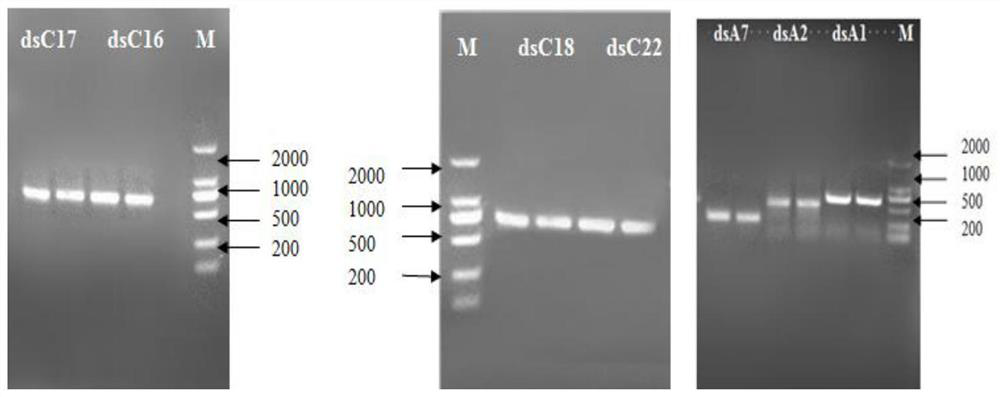Application of ABC transport protein to agricultural pest mite control and Bt resistance management
A transporter and agricultural technology, applied in the biological field, can solve problems such as off-target effects
- Summary
- Abstract
- Description
- Claims
- Application Information
AI Technical Summary
Problems solved by technology
Method used
Image
Examples
Embodiment 1
[0029] In vitro synthesis of embodiment 1 Turkestan spider mite dsRNA-ABC
[0030] (1) Primer design for ABC gene dsRNA of Turkestan spider mite
[0031] Use Primer5.0 to design dsRNA synthesis primers for ABCA1, ABCA2, ABCA7, ABCC16, ABCC17, ABCC18 and ABCC22 genes respectively, add T7 promoter in front of the designed dsRNA synthesis primers, and add GG after it (GG can increase dsRNA synthesis quantity). See Table 1 for details.
[0032] Table 1 dsRNA synthesis primers of ABC gene of Turkestan spider mite
[0033]
[0034] Note: The italic letters in the primer sequence indicate the T7 promoter sequence.
[0035] (2) Synthesis of Turkestan spider mite dsRNA-ABC template
[0036] Using the ABC gene as a template, the primers synthesized by the dsRNA in step (1) were used for PCR amplification. The PCR reaction system is shown in Table 2.
[0037] Table 2 PCR reaction system
[0038] Reagent quantity 10x PCR Buffer (2.5mM) 2.5μL dNTP Mixture (...
Embodiment 2
[0045] Example 2 Sensitivity Analysis of Turkestan Tetranychus ABC Gene Silenced to Bt Activating Toxin
[0046] (1) Experimental objects: the sensitive strain Tetranychus turkestan, the strain resistant to Cry1Ac activated toxin and the strain resistant to Cry2Ab activated toxin;
[0047] The sensitive strain Turkestan spider mite is a descendant strain that has never been sprayed with any pesticide since 2010, and it has been raised on potted cowpea seedlings for 160 generations;
[0048] The Cry1Ac-activating toxin-resistant strain Turkestan spider mite and the Cry2Ab-activating toxin-resistant strain Turkestan spider mite were selected from the sensitive strain Turkestan spider mite through Cry1Ac-activating toxin and Cry2Ab-activating toxin respectively. 9.18 and 20.64, respectively.
[0049](2) Test items: Sensitivity to Cry1Ac activating toxin or Cry2Ab activating toxin after gene silencing of Tetranychus Turkistan ABCA1, ABCA2, ABCA7, ABCC16, ABCC17, ABCC18, ABCC22; ...
Embodiment 3
[0060] Example 3 Effect of dsRNA-ABC on hatching rate of Turkestan spider mite eggs
[0061] (1) Experimental method:
[0062] Pick 20 healthy female adults of Turkestan Tetranychus mites, put them into leaf discs (the preparation method is the same as the embodiment step (31)), put 1 head in each grid, allow them to lay eggs for 24 hours, and then remove the female adults and redundant eggs , a total of 60 eggs were retained. Add 0.2 μL of dsABCA1, dsABCA2, dsABCA7, dsABCC16, dsABCC17, dsABCC18 or dsABCC22 synthesized in Example 1 dropwise to each egg with a micropipette. CK control group was dripped with ddH 2 O, placed in a biochemical incubator to cultivate, observe and count the hatching rate of eggs and the survival rate of larvae after 72 hours of hatching. Each treatment had 3 biological replicates, and each replicate had 60 eggs of Turkestan spider mite, a total of 180 eggs.
[0063] (2) Experimental results: as shown in Table 4.
[0064] Table 4 The effect of ds...
PUM
 Login to View More
Login to View More Abstract
Description
Claims
Application Information
 Login to View More
Login to View More - R&D
- Intellectual Property
- Life Sciences
- Materials
- Tech Scout
- Unparalleled Data Quality
- Higher Quality Content
- 60% Fewer Hallucinations
Browse by: Latest US Patents, China's latest patents, Technical Efficacy Thesaurus, Application Domain, Technology Topic, Popular Technical Reports.
© 2025 PatSnap. All rights reserved.Legal|Privacy policy|Modern Slavery Act Transparency Statement|Sitemap|About US| Contact US: help@patsnap.com



